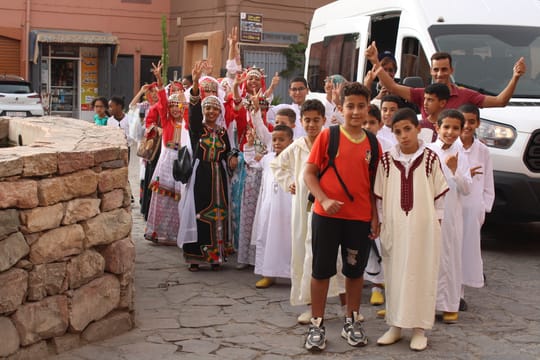Heritage Education at an Elementary School

By Omaima Khalil Elfanne, Dakira Cultural Coordinator

Elementary school in the Tiznit province discovers the cultural heritage of the city. Photo: HAF
Culture refers to the knowledge, tools, and attitudes accumulated over generations that permeate the child’s immediate environment, including the cultural “practices” of nuclear family members and relatives, tangible and intangible heritage, traditions and customs. These enculturated members of society are themselves subject to a variety of influences from both the natural environment and the community as they carry out their roles, which may include caring for others and earning a living. Learning is seen as the relatively lasting change in behavior or understanding that results from the child’s experience.

Elementary school children from Tiznit during the discovery of Ain Zarqa and Kasbah Aghenaj. Photo: Abdelghani Kastih/HAF
It is within this framework that the USAID Dakira program considers children’s learning to be an essential factor in the process of preserving culture and heritage, playing a crucial role in the way children interpret the world. During the second phase of school activities conducted with more than 1,800 students from 45 rural and urban schools in the Tiznit province, the High Atlas Foundation (HAF) team adopted a framework for knowledge-building and information-sharing to consolidate the relationship between the child and its heritage, thus empowering them to recognize and organize information. This has helped them to understand the meaning of heritage and to adopt appropriate tools (symbols, meanings, scenarios, objectives, narratives) for learning about their culture.

Elementary school students visit Tiznit from Bab Ouali to Bab Jdid. Photo: HAF
The study of culturally mediated learning must take into account a cultural context that cannot be replicated in the laboratory. The tool deployed during this phase was through field trips organized for the students with the accompaniment of a guide, to introduce them to the heritage and local culture of Tiznit. The circuit starts from Bab Ouali, which means “cattle” in Tachelhit, and ends at Bab Jdid at the end of the great wall that surrounds the ancient city of Tiznit, passing through different stations of historical monuments, where they learn a brief history of the site as well as the history of Tiznit. This circuit is intended to teach the students the richness of their region’s cultural heritage and to ignite their curiosity to document more, and to dig deeper, to know their heritage better.

The students during their visit to the historical sites. Photo: Abdelghani Kastih/HAF
At a young age, children are still developing the ability to consciously grasp and analyze the meaning of the world around them. The understanding of meaning is therefore derived from physical contact with objects and is constantly linked to action.
Nevertheless, from birth or shortly thereafter, children are highly sensitive to the consequences presented by all kinds of events in their environment. This may involve recognizing the usual sequences of activities, the varied reactions of people around them, or the links between the phonemes of the language they hear, which will form the basis of the grammar of their mother tongue. In this context, Dakira aims to have this direct contact with the local heritage of these children in order to consolidate their link to it and better guarantee their sense of belonging.
The USAID Dakira program, implemented by the High Atlas Foundation and its partners, aims to strengthen inter-religious and inter-ethnic solidarity through community efforts that preserve cultural heritage in Morocco.
This article was completed with the support of the United States Agency for International Development (USAID), and the High Atlas Foundation is solely responsible for its content, which does not necessarily reflect the views of the USAID or the Government of the United States.